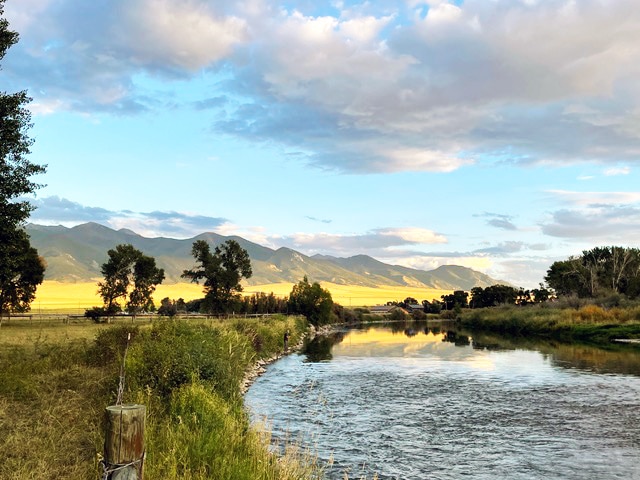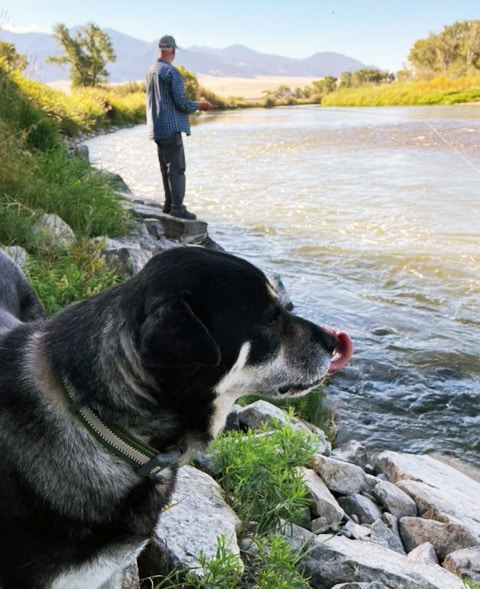Community Environment
In the Margins: Back to school in a classroom of river, sky and maybe even some fish
As our summer yielded to fall, I took myself back to school. My classroom was a quiet stretch of the Jefferson River in Montana, nestled between the Continental Divide to the west and the Tobacco Root Mountains to the east.
Our annual eastward pilgrimage to this region is disguised as a family obligation to help my father-in-law as he navigates the challenges of being mid-80s on a remote ranch tucked into a graceful elbow of the river. But if we’re being honest, the trip is a restorative reprieve from homebound routines and a good excuse to escape that ridiculous intersection at Olympic Drive and Point Fosdick.
A hall pass from ‘visiting’
Our time at the ranch typically is spent chasing a stubborn Australian Shepherd out of the kitchen and engaging in an activity my wife calls “visiting.” With the experience of 41 years of marriage, I have learned that “visiting” translates as “talking at length about things that keenly interest two people and probably hold remarkably less interest for anyone else.”
Like a distracted high school senior enrolled in Advanced Biology, I needed to create a graceful exit from Visiting 101 without tarnishing my GPA score as husband and son-in-law. I found a solution in the dusty recesses of my garage attic — a storage bin of fly-fishing gear. I had carefully packed it away in the mid-1990s, when family duties gradually displaced fishing trips.

This view made the trip worth it, even if the fish weren’t biting.
Reopening the bin was like releasing a cathartic time capsule: reels, leaders, spools of line, and a rumpled fishing vest all still smelled like the upper section of the Elwha River (before the dams were removed). Small containers revealed rows of colorful artificial flies lined up like a Smithsonian exhibit of bugs collected by John Muir during his treks into the Cascades. Better yet, I had discovered a legitimate hall pass that allowed me to skip Visiting 101 in favor of some solitary time on the banks of the nearby river.
‘Why do you do this?’
But going back to school after decades of absence is never quite as idyllic as we might imagine. Based on casual advice from a fly shop in St. Regis, Montana, I attached something called a “purple haze” (apologies to Jimi Hendrix) and reminded myself how to cast into the bubbling eddies and swirling holes of the river’s languid wash. It felt great: The tick-tock cadence of fly casting came back to me like riding my Huffy three-speed bike in sixth grade. The fly artfully played its part as a tempting river-borne teaser.
The table was set, the meal was prepared, but someone forgot to invite the trout. I felt nary a bite after an hour, and the solace of being on the river gradually gave way to the fact that I was failing in my self-instructed class. When my son stopped by for a swim somewhere downstream, he eventually came back to ask me: “So why do you do this, anyway?”
Good question. His reasonable query haunted me for the rest of my time on the river, so I set out to find an answer. After returning troutless to Gig Harbor, I sat down for some remedial work with Blake Merwin, proprietor since 2009 of The Gig Harbor Fly Shop. In less than an hour, Blake reminded me: 1) why I love the act of fly fishing, and 2) why I am not very good at it. Here are my classroom notes from office hours with the insightful Professor Merwin:
Fishing is not about the gear, it’s about the fish
Too often we think of fly fishing versus conventional fishing as distinctly separate pursuits. We fall into the trap of thinking one camp is better or more worthwhile than the other. We sometimes put fishing disciplines into a false dichotomy like Chevy vs. Ford or iPhone vs. Android. In fact, joy and skill come from finding a way to catch fish in a way that respects the species and the environment regardless of the gear we load into the back of the Subaru.
Evolve your fish eyes
Blake mentioned he has developed what he calls good “fish eyes.” When he said this, I knew exactly what he meant. During my recent time on the river, I was still using terrestrial human eyes. I was fishing blind — forgetting how I used to be able to look at the water for tell-tale (tail?) signals of finned inhabitants. Without practiced vision, the fishery all just looks like water, flat and lifeless. But with evolving fish eyes, we begin to see the water as something more — hints of a habitat where so much life is lurking beneath the surface.
Fishing is about deception
Whether we’re fly casting on Montana rivers, bobbing in a tin boat on Lake Crescent, or paddling a kayak through an intertidal zone outside the mouth of Gig Harbor, the game is one of trickery and nuance. The fly (insert bait of your choice) is nothing but a lie. The more nuanced the lie, the better chance a fish will bite. Fishermen call it “matching the hatch.” When our fly-lie is effective, our offering closely resembles whatever is being served as the ecosystem’s daily lunch special.
After my unproductive casting with the “purple haze,” a local rancher mentioned to me, “They’re getting good hits on grasshoppers down this side of Twin Bridges.” Well, so much for my Jimi Hendrix special. Turns out, my deception was all wrong. I was a lousy liar on the river that day.

Nobody in this picture found much in the way of fish in Montana’s Jefferson River this summer.
Fish local, think global
I first learned to love fly fishing when a patient friend, a native of Port Angeles, escorted me upstream into the Olympics. We caught and released dozens* of rambunctious trout, and I was hooked. I saw freshwater rivers with a dry fly as the Shangri La for fishing; I was convinced that trout were the ultimate aquatic quarry.
Alas, my session with Professor Merwin reminded me that I was naïve and narrow-minded. He described guided outings that focus on a wide range of species and environments. They go to nearby lakes, local saltwater estuaries, and Montana’s Missouri River. They pursue winter steelhead on the Sol Duc, tiger muskie on the lakes feeding the Cowlitz, or sea run cutthroat trout that spawn right here in Burley Creek.
During the off season, they pack passports into their tackle boxes and head off to places like Cuba, Belize, Mexico, and Christmas Island (go to Honolulu and make a hard left). In international waters, they pursue everything from ubiquitous bonefish to the challenging and elusive tarpon.
I was reminded that the universe of fly fishing flourishes both locally and globally – right here in the saltwater of our front yard and in many enticing places far beyond our region. Trout fishing on rivers only scratches the surface.
“Saltwater is more my thing,” said Blake. “Coho on a fly rod is about as much fun as you can have fishing … I don’t go to the Yakima and fish for 10-inch trout anymore.”
Even a guide needs a guide
When Blake’s local fishing guides stray from their home waters, they too rely on guides from the regions they are visiting. They put pride aside, and they’re smart enough to appreciate local know-how. Blake said he’s often humbled by what he learns from one guide who knows exactly how many days per year he has fished the Upper Missouri River.
“These fishing situations are a team experience,” he said. “Anyone, no matter how experienced, can still learn.”
Remedial studies
After my remedial session with Professor Merwin, I realized that my recent troutless adventure on the Jefferson River was not a complete defeat. Like a wide-eyed college freshman, I had failed the first exam. But I also learned where to go for help, and how to ask for guidance. I realized I would have to improve my fish eyes and my deception skills.
As in life, success with fishing seems to start with admitting what you don’t know. I can’t wait for next year, when once again I will plan to gracefully escape Visiting 101 for another study hall session down by the river.
- “Dozens” is a vague numerical term used by fishermen to describe and inflate any number of fish caught on given day.

